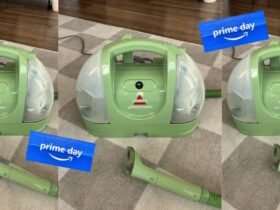Hi, it’s me: the crazy person who made a 2+ hour-long video reviewing grocery stores!
Did you think I was done? Never! I’m the Saiyan warrior of personal finance writers. If a topic brings me to the brink of total annihilation, it only makes me more powerful. The positive response to that video was the senzu bean I needed to bounce back with even more cheap grocery shopping wisdom. To our new readers: welcome. To our new Patreon donors: thank you.
Many readers lamented that they live far away from the stores featured in my investigation. With them in mind, I challenged myself to come up with some really juicy, delicious advice that could apply to everyone who shops for food. And I think I’ve managed to do just that.
Today’s advice is universal. These are *cosmic truths* about grocery shopping. They will save you money on food, no matter what you buy or where you shop. If rising food prices are a source of stress in your life—as they are in mine!—I promise you’ll learn something helpful.
1st Cosmic Truth of Cheap Grocery Shopping: Where you shop matters as much as what you buy.
I already did a deep dive into grocery store price comparisons in To Hell And Back for Cheap Groceries. And when I say “a deep dive” I mean Active-Lava-Zone-deep. Sea-Dragon-Leviathans-Working-Loss-Prevention-deep. Any deeper and we’re just inside the mantle!
The tl;dr of that investigation is this: an average shopping list costs $157 at one store and $82 at another. Which means that where you choose to shop has an enormous impact on how much money you’ll spend on groceries throughout your lifetime.
A lot of people shop based on convenience: which store is closest to home or work, which stocks everything in one place, which are least crowded… and that’s completely understandable! But if saving money is your top priority, you should know that a few extra minutes in the car or checkout line could lower your bill—realistically by 10-20%, but potentially by as much as 50%.
The cost savings at the cheapest stores may justify added expenses like grocery delivery, curbside pickup, or a bus ride or ride share to get to the store. At the very least, you can save money doing big, infrequent trips to the cheaper store for shelf-stable and freezable foods. To paraphrase Jess, “cheat on your grocery store—it’s not your girlfriend.”
That’s my only repeat! Everything that follows is brand advice you’ve never heard from us before.
2nd Cosmic Truth of Cheap Grocery Shopping: Look up and look down.
Here is a photo of the granola section at one grocery store. And here is the same photo, with a heat map of its unit prices. Highest prices are in red, lowest prices are in blue.

Here’s another for a different store’s olive oil section.

This can vary a lot based on the store, but in general, your best values are likely to be on the top and bottom shelves. Generics and bulk-size items are usually the best value, and they’re both often found on the top and bottom shelves. On the other hand, bestsellers and the most recognizable brand names are usually at eye-level.
My knees crack super loud every time I kneel down. My fellow shoppers are just gonna have to deal with the gunshot-like retorts issuing from my legs, because I do most of my shopping in a gargoyle crouch.
3rd Cosmic Truth of Cheap Grocery Shopping: The unit price always tells the truth.
Take a look at this salacious, never-before-seen photo. It shows the prices of two Red Baron pepperoni pizzas. They’re from the same store, same section, and same brand, on the same day.
They also cost the same amount.
… Or do they?

The retail price—the big number on the right—says they’re both $5.99. There’s even this extra call-out on the bottom that repeats the price, as if it’s so shockingly low they assumed I’d see it and exclaim “wh-wh-why that can’t possibly be right!” Thank you for anticipating my fragile emotional state, Stop and Shop. I feel so supported.
… But the truth is that the pizza on the right is 25% more expensive than the pizza on the left.
(Sometimes photos just aren’t enough. Luckily, my last video on groceries netted us quite a few new Patreon donors. From the bottom of my heart, welcome and thank you! To show my complete and utter contempt for their generosity, let me now reveal that I’ve used their hard-earned money to buy multiple Red Barron frozen pizzas. If you want to see exactly how similar they are, check out the video version of this article.)
Left Pizza is “classic crust” and Right Pizza is “thin crust.” Their boxes are the same size and shape; their price is the same; if you glance at them, your lying eyes will tell you they cost the same. But the thin crust has substantially less food product inside. This is true for both volume and caloric density. At 1,520 vs 1,200 calories for the same retail price, a hundred calories of Classic Crust pizza costs 39¢ to Thin Crust’s 50¢. This is somewhat obscured by switching the serving size from 1/4 of a pizza to 1/3 if you turn it over and check the back.

How do I know this?
It’s because I’m ignoring the big price tag and focusing on this little number to the left. This is called the “unit price.” And it tells you a standardized price calculated by a fixed objective number, such as weight, volume, or item count.
With this number, you can look at a wall of products in different sizes, different shapes, different quantities, from different brands, and quickly find the cheapest one. You can also understand how much you’d save by buying in bulk.
Now, half of you are hearing this and saying: “Yeah, no shit, Sherlock!” You, like me, were taught to read unit prices. Probably at such a young age that it has become second nature.
But the other half of you are saying: “Wait, that’s what that extra number’s for?!”
Occasionally I’ve found myself shopping with someone who wasn’t taught how to read unit prices. They see me glance at a vast selection and quickly and confidently pick out the cheapest option. And they react like Judge Claude Frollo seeing street magic.
If you were never taught this, do not be embarrassed. It’s a representative example of an adulting skill that’s not formally taught anywhere anymore because we assume everybody already knows it. This is neither here nor there, but I believe life skills classes should arise out of the stone-cold ashes of the home economics tradition to bridge exactly these kinds of knowledge gaps.
I’m an old enough Millennial that I had a home ec class. They did not teach me about unit prices. No, they taught me how to machine-sew a gym bag. Presumably because the school owned 30 sewing machines and didn’t have the heart to Brave Little Toaster them. What’s really funny is that I actually enjoy sewing nowadays… but I can’t afford to do it because our globalized market means the raw materials for making artisan handicrafts at home are magnitudes more expensive than buying finished products. Sadly, I know this because of my… excellent unit price reading comprehension.
Once you know how to do it, reading unit prices is really damn easy. The only potentially tricky part is making sure the unit of measurement is the same for any products you’re directly comparing. Overwhelmingly, the unit prices on solid foods are described in pounds. But liquids are a little more variable. For example, olive oil that’s sold in giant metal tins might list its price by the gallon, while tiny bottles of fancy imports might price per fluid ounce, while the stuff in the middle is by the pint. (“It comes in pints?!”) It’s up to the retailer, but they always list the unit of measurement in tiny text underneath the unit price.
If this is your first time hearing unit prices clearly explained, please tell me so in the comments. Only because it would really make my day to know I could teach you something so simple yet so valuable.
4th Cosmic Truth of Cheap Grocery Shopping: Avoid buying water.
When I say “avoid buying water,” I’m not really talking about drinking water. (Although we have strong thoughts on that, too!) Rather, it’s about maximizing the ratio of The Thing You Want versus The Thing You Don’t Want in any product.
Water is the one “grocery” item that every single person on the planet needs. Luckily, it’s notably abundant on this, our little blue planet (some restrictions apply). The need for water is so universal you probably have pipes that deliver it, on-demand, into several locations in your home.
So, water is essential, water is common… but it’s also heavy. And weight is often the key factor determining a grocery item’s price. It’s almost always MUCH more economical to add water at home.
Let’s look at an example.

This is the dish detergent I use. It comes in a cardboard box full of powder. The powder is exactly what I want: the surfactants and solvents that clean dishes. There’s no water inside this box—all of that gets added in my home, by my dishwasher. The result is something that’s both effective and very cheap, at 8¢ per load. The only thing I paid for that I don’t want is this cardboard box, which is generally both biodegradable and recyclable.
Alternatively, I could buy a liquid version. It’s the same brand and it costs about the same per ounce. But because it’s far less concentrated, you have to use more of it. It’ll cost you 22¢ per load. You’ll have to buy more of it to wash the same number of dishes, and each time you do, you’ll be left with a huge plastic jug. From an environmental perspective, this is what’s known as “bad.”
With liquid detergent, the majority of what you’re paying for is no longer The Thing You Want (detergent). That now comes in third place, after two Things You Don’t Want (water and plastic). But all that extra water makes liquid detergent cheaper for Cascade to produce, so they’ll market it and force grocery stores to stock it until it becomes the default in many households.
I can’t always find powdered dish detergents in stores anymore. When I do, it’s typically on the topmost or bottommost shelf. They’ve been pushed out of view by trendy pod cleaners, which are even more expensive per load than liquid detergents and come sooooo wrapped in plastics (both micro and macro) I believe they technically could be classified as mummies.
In fact-checking myself, I found that Consumer Reports has stopped testing powdered dish detergent altogether. Not because it doesn’t work—it does!—but because people just don’t buy it anymore.
…sigh…
Where else can we find excess water in the grocery store? I’ll highlight a few places.
Water in cleaning agents
Laundry detergent is very similar to dish detergent. Pods < liquid detergent < concentrated detergent < powdered detergent < concentrated powdered detergent. I’ve switched to dry strips, and I have no complaints, especially concerning cost and ease of use.
Cleaning fluids typically come in wasteful liquids AND more economical concentrated formulas and dry powders.
Water in drinks
Drinks are obviously a huge source of water. Bottled drinking water, sodas, seltzers, alcohol and mixers, juices, milks, and liquid canned goods are probably mostly water by weight. If you can get a concentrated version of any of those products, doing so will maximize your savings.
For example, a 12 oz bag of dry coffee beans costs $7.29 and makes about 16 cups of coffee, meaning each one costs 45¢. Prepared coffee from the same brand costs $6.39, but holds only 2.6 cups of coffee, making each cup cost $2.40. If you drink two cups of coffee a day, you’d have to buy more than five of the damn things every week and the earth is left with half a dozen more plastic jars to swallow.
Water in fresh fruits and vegetables
Fresh fruits and vegetables have a lot of water. Which is good! We love watermelons and cucumbers in the summer because they’re deliciously hydrating.
In the history of the internet, no credible person has ever told their readers to eat fewer fresh fruits and vegetables—and I refuse to be the first! But if there’s no difference between a fresh food and its frozen equivalent, the frozen version often has more food and less water.
Think of something like frozen spinach. It’s blanched before it’s frozen to deactivate its enzymes, because if we didn’t do that, the enzymes would keep working even when frozen and you’d end up with really slimy, weird textures. But the blanching also removes excess air and water from the leaves, which then compress even further as they freeze. So if you’re getting it for salad, fresh is best. But if it’s going into minestrone anyway, you’ll get more bang for your buck financially and probably nutritionally by choosing frozen.

Water in unnecessary packaging
Look for the phrase “from concentrate.” This means they added water, put it in a bigger container, and are charging you for the effort. If it says it’s from concentrate, look around to see if you can find it in frozen or powdered form and skip the middle man.
In general, any packaging innovations that remove moisture are at least worth trying. I’ve found applications for low-moisture mozzarella, packet-style tuna, dehydrated fruits, and concentrated soup stock in my kitchen. And Jess, our resident outdoorsy one*, swears by this kind of packaged stuff for easy camping food!
… That’s the end of the anti-water section. r/hydrohomies is gonna cancel me!
5th Cosmic Truth of Cheap Grocery Shopping: Don’t pay extra for packaging.
It’s always best to buy whichever version of a product comes with the least amount of packaging. From both a frugal and an environmental perspective, “none” is the platonic ideal of food packaging. (One of many reasons garlic is the perfect food. They don’t even need produce bags! Its papery shell is nature’s perfect wrapper!)
But I also mean this in a different sense—one that, as a former graphic designer, I’m very qualified to talk about: product design, and all of its manifold lies.
There are so many ways a designer can trick customers into paying more for an item than they want to. I’ll highlight a few of the most prevalent ones so you can start to spot them in a store near you.
Shrinkflation
Has this happened to you? You pick up a familiar item from a store shelf and find it suddenly feels… wrong? Different than you expected? Like you’ve gone to tenderly honk the boob of your DD lover, and sudden find only B cups awaiting you?
Shrinkflation is one way of tricking customers into paying more for less. When companies want to raise their prices invisibly, they put less food product into the box while keeping prices level.
Obviously this would make customers angry, so companies subtly alter the package’s dimensions. For example, they might keep the height and width of the box the same, while making it slimmer.
In my opinion, the most egregious examples in recent years have been cereal boxes. General Mills, Kellogg, Post, Quaker Oats—all of America’s largest cereal manufacturers have been caught playing games with package sizing. They’ll drop the weight of each item while keeping costs steady, then introduce a new larger version that’s more expensive to the consumer (and more profitable to the company).
Many companies used COVID and its ensuing supply chain snarls to justify cuts. Interesting to see how many of them have persisted in the ensuing years… It’s almost like Jess was right when she posited that corporate greed and industrial opportunism was hiding under the Scooby-Doo villain mask of “inflation.”
But that can’t be. A bunch of *really helpful* men came to the comments section to tell her to calm down because she was just being hysterical. So it must be something else…?
Ughhhh. Guys, writing is so hard! I have to make a bunch of words and pictures in my head, and there’s no comments section until I publish it! So I’m all alone! If you can provide me with stern yet loving paternal guidance during the drafting phase, please offer your services in the comments! We yearn for the sweet release of bimboification. Please helping us understand business and economy more well.
Anyway, the only way to object to shrinkflation is to buy less of the shrinkflated product. Which in the case of cereal, many consumers did! General Mills reported 5% higher sales in 2020, but by 2022, they’d slumped by over 12%. CEO Jeff Harmening blamed that drop on “stronger-than-anticipated value-seeking behaviors.”
… Which is soooome corporate speak! “Unfortunately, after fucking around, we were surprised and saddened to have found out.” I didn’t read the full press release, but I assume he followed this up with: “We projected the consequences of our price gouging wouldn’t arrive until after I’d cashed out as a shareholder. I therefore humbly apologize to myself.”
As that multiyear slump demonstrates, it takes time for consumers to notice the difference and adjust their purchasing patterns. That’s why I’d love to see a consumer protection law address this. I think it would be very fair to ask that product reformulations and size changes should be called out, directly on the packaging, for a few months afterwards.
But what do I know! I’m just a girl. I can’t read. And I don’t know what a store is.
This isn’t exclusive to existing products. Pasta, for example, has conventionally been sold in one pound boxes. Which acclimated us to accepting that different size and shape boxes were all actually the same. But when consumers demanded wheat-free pastas, companies answered—just not in a one pound denomination. I feel really bad for people who rely on this stuff, and are getting less of it.
False promises
For years, the package for Canada Dry Ginger Ale proclaimed: “Since 1904, Canada Dry, 100% Natural Flavor, Made from Real Ginger.”
The health benefits of ginger are pretty well-documented. We know it has natural anti-inflammatory and anti-nausea effects that aid human digestion. So a lot of people bought this product, believing that what the packaging said was true.
Kitty: (Pause.) It wasn’t true.
A lawsuit against the company revealed that the actual ginger extract in Canada Dry was only two parts per million. That’s below the threshold for human taste, let alone the amount required to produce health benefits.
And it’s not like this is a rare occurrence.
- Kraft’s Olive Oil Mayonnaise is made with canola oil and soybean oil.
- Welch’s Fruit Snacks’ trademark is “fruit is our first ingredient” but it’s only true because they split sugar and corn syrup to artificially force fruit to the top of the list.
- Plant-based products come with labels that say “No Cholesterol!” despite the fact that cholesterol is only found in animal products. So brave.
- Single-ingredient foods like popcorn kernels describe themselves as “all natural.” I’d hope so? Orville Redenbacher, what were the unnatural things you considered but ultimately decided against??
Packaging is filled with nice-sounding descriptions companies don’t expect to be challenged on. They’re as credible as the exclamations of a Depression Era carnival barker.
A nice coat of paint
This is obviously true of brand name versus generic products. For the video version of this article, I opened a Kellogg’s Frosted Mini Wheats, and a generic frosted shredded wheat cereal. Once poured out into bowls, I absolutely couldn’t tell the difference. Which is kinda wild, considering one costs $3 per pound, and the other costs $6 per pound!
As the saying goes, “we eat first with our eyes.” (That quote is two millennia old, by the way—and it’s been true the whole damn time!)
The way products look is NEVER an accident. Brands use every element of an item’s packaging—fonts, shapes, colors, textures, words, abstract associations—to shape expectations of a product long before you taste it.
Let me show you what I mean!
Here are several bottles of wine. They range in cost from $6 to $190. At a quick glance, which ones catch your eye? What would you expect each bottle to cost?

I sent this photo to a few friends. The leading guess was that the $190 bottle was either #1, #5, or #6. But all of those guesses were wrong. The $190 bottle is #2, and it’s the only real brand on this list. In case it wasn’t obvious, all the others are brands I invented over the course of two episodes of Upstairs Downstairs.
They all contain the exact same liquid, which is $6 worth of food product. From there, it’ll be marked up to whatever the distributor’s market research suggests their target demographic is willing to pay for it.

When I worked as a designer, my job wasn’t to make things look pretty—it was to set traps. Let me point out a few I’ve lain here:
- Make your company sound quaint when it isn’t.
- Imply that the company is woman-owned when it isn’t.
- Borrow visual signifiers from anywhere you want to elevate the brand by borrowing that culture’s caché within that space.
- Put any text inside laurel leaves, it’ll look like an award.
- Put any text inside a badge, it’ll look like some kind of certification.
- Tell people what it tastes like before they can decide for themselves.
- Gold means good.
- Old means good.
- Illegible fonts mean fancy.
- Bright colors mean fun.
- Subdued colors mean serious.
And I will use them all, hoping that at least one of them will appeal to you.
See, companies fundamentally want two things: high profit margins and large market share. You get high profit margins when you sell products for more than it costs to make them, and you gain market share when you sell to as many people as possible. There’s a lot of tension between those goals, but clever packaging can help you do both.
Let’s say that every day, a hundred customers walk into a store wanting to buy wine. My fictional wine distributor wants to maximize their profit margin by offering their wine at the largest markup possible. But if they did that, they could only capture the 1-2 wealthiest customers. So they diversify the offerings and their price points to get as close as they can to winning every customer’s sale.
Wine is a convenient example because it’s famously subjective and open to opportunistic pricing. But make no mistake: food manufacturers are trying to create tiered pricing structures in every category of foods.
This is why a company like Post Cereal offers Bran Flakes, Honey Bunches of Oats, Pufffins, and Oreo O’s. They have massive piles of enriched wheat, oats, corn—cereal stuff—plus the industrial facilities to process it into any shape, texture, and flavor they think will sell. Then they’ll package them into surprisingly different sub-brands to appeal to YOU—and by “you,” I really mean “everyone.”

The supermarkets our grandparents visited would’ve only had one or two varieties of apples, but today I can pick from over a dozen. There are now normal apples, luxury apples, and ultra-luxury apples. Whether that’s progress or enshittification is mostly a matter of perspective. Either way, stratification is coming for everything.
If you shop without your guard up, people like me will get you. You’ll be suckered into buying things that just look better to you, which will result in you paying more than you have to.
And you may end up with a wine that has a perfect attendance award.
6th Cosmic Truth of Cheap Grocery Shopping: Taste cheap food often.
If there’s a way to win this sneaky wine bottle game, it’d be to buy the least expensive wine and see if you like it. Like it, and you’ve won! If you don’t, try the second least expensive wine next.
I’ve done a lot of blind taste-testing over the years, so let me be the first to say: some foods really do just taste better than others. But in my experience, the best-tasting item isn’t always the more expensive one.
For example, a few years back, Bitches Get Riches did a comprehensive blind taste test of cheese crackers, which you can read here. It’s a really funny one, if I do say so myself.
In that test, one of the testers was really excited for Annie’s Cheddar Bunnies. He knew they were pricey and organic, so he expected them to taste really good. Now, the Bunnies have a unique and recognizable shape we couldn’t conceal in the test. He knew when he got the Bunnies, and his score for them was really high. What he didn’t know was that it was the second Annie’s cracker he’d eaten in the taste test. Annie’s Organic Cheddar Squares had already gone, and without their novel shape, he’d described the same recipe as “bland and unimpressive.” His favorite was actually the cheapest crackers on the test: a generic store brand that cost 2.5x less than the brand name Cheez-It they sought to imitate.
Now, if you’ve tried the cheaper or generic version of a food, and you remember it being bad… give it a few years, then try it again. Here’s why.
There’s a really interesting race happening between brand-name enshittification and generic brands racing to capture market share by perfecting upon their recipes. Basically, one is getting worse while the other’s getting better.
For example, you may have hated the dusty generic chocolate sandwich cookies your Gram-Gram offered you in childhood. You may think you have a strong preference for true Nabisco Oreos. But if you did what we did, and actually looked at them with fresh eyes in another blind taste test, you’d probably notice how much the quality had slipped in the years since that brand loyalty formed. The little discs of creme were shrunken and thin, leaving the edges of the cookies bare, and we all noticed it. (We were shocked to be collectively struck by real romantic love for the surprise winner of that test—another good one you can read here.)
And this isn’t just true of processed foods.
Take the humble jalapeño. I love spicy foods, so I love jalapeños! Or at least, I used to.
Recently, I finally accepted that jalapeños are enshittified to the point where I’d no longer say I enjoy them. My fingertips use to burn as I cut them, but now I can eat the whole thing raw. Just chomp it down to the stem, like an apple.
This isn’t my imagination. Food processors have promoted the proliferation of an unspicy variety, the Tam II, to which they can add liquid capsaicin at a controlled rate. This gives them predictable results and full control over the spice level of a packaged product. And supermarkets like it too, because they’re huge and uniform with minimal corking. The result is a taste that’s indistinguishable from a green bell pepper.
Sigh… so that’s it for me and jalapeños. For now.
This isn’t to say that everything always gets worse. The Honeycrisp Apple dealt a just deathblow to the disgusting Red “Delicious” apple and saved us from its mealy tyranny. We bred the appalling bitterness out of Brussels sprouts by cultivating varieties with less glucosinolates. And we did that with traditional plant-breeding practices—no nefarious gene editing or anything like that. Things get better as often as they get worse!
So even whole, natural foods can change to the point where you flip on whether you like them or dislike them. The only way to know is to taste cheap foods more than just once.
7th Cosmic Truth of Cheap Grocery Shopping: Put a fair price on your own labor.
Grocery stores offer a lot of conveniences: frozen prepared foods, ready-to-eat foods, precut produce, premixed salads, preshredded cheese, baking mixes, canned meals, boxed meals, individualized “grab and go” portions, curbside pickup, grocery delivery…
Some of those conveniences are worth it, and some are not. It depends on two things.
- How willing/able are you to perform that labor yourself?
- How much does it cost to outsource that labor?
My neighborhood Market Basket sells giant rotisserie chickens for $9.99. The cost of a whole, raw roasting chicken of the same size is actually a few pennies more. If I bought the raw chicken instead, it’d probably take me about two hours to roast it myself, including washing dishes afterward. If I were paying myself with the money saved, I’d actually lose money. By buying this convenience, I’m acknowledging that my time is more valuable than that. (Also they make it taste really damn good.)
On the other hand, shredded cheese costs ~$1 more per pound. Grating an entire block of cheese and washing the grater afterwards is a five-minute task. That’s a fair wage for me, especially since I get to pick at all the cheese I want during the process! It’s also worth noting that the convenient product is notably inferior, as I’m very bothered by that anti-caking cellulose that leaves a strange powdery texture all over the cheese and makes it melt weird.
If you can’t do something (or loathe doing it), and the cost isn’t that much higher, those are wise conveniences to pursue. Otherwise, the less disposable income you have, the more you should challenge yourself to do things the hard way.
That said, it’s totally natural to go through phases of your life where your time is more valuable than your money, and vice-versa.
8th Cosmic Truth of Cheap Grocery Shopping: Half of your cart should probably be fruits and vegetables.
I’m not a nutritionist or a dietician. I have no formal training in food science. So I’m only going to offer the broadest, blandest piece of advice in this area.
You would save a lot of money if you aimed to fill half of your cart with fresh fruits and vegetables. This is a financial recommendation, and one I feel comfortable making, because it also seems to be the one piece of nutritional advice that almost everyone agrees is a pretty good idea for almost all people.
I’m a prolific home cook and I love the challenge of cooking for people with tricker dietary needs. I’ve filled grocery carts with ALL sorts of people in mind. It’s my experience that the most expensive people to shop for are those who eat a lot of meat, seafood, dairy, and processed specialty foods (stuff like gluten-free bread, meat-free burgers, dairy-free cheeses, and grain-free granola). The cheapest people to shop for are the ones who eat primarily from the least expensive department: fresh produce.
9th Cosmic Truth of Cheap Grocery Shopping: Shop according to your principles, not your anxieties.
Certified organic. All natural. Cage free. Grass fed. Line caught. Hand selected. Air dried. Pasture raised. Hormone free. Non-GMO. Fresh picked. Flash frozen. Ancient grain. Minimally processed. Post-consumer recycled. Lightly salted. Naturally flavored. Locally grown. Family owned. Ethically sourced. Human grade.
Food labels are a very contentious issue right now. That’s good! It’s an important discussion that deserves robust debate. Yet I’m not really going to dive deeply into this subject because we don’t run ads on our site, so I gain nothing from rage bait.
All I’m going to point out is that terms like the above are an extremely mixed bag. Some reflect extremely important evolutions in food safety that are standardized, certified, verified, or subject to audit. Others are deliberately misleading meaningless trickery. They’re used as product differentiators, to signal virtue and value that justify a higher cost. They’re synonyms for the word “better.”
To avoid being deceived, I urge you to shop according to your principles—not your anxieties.
As a former marketing professional, let me attest that it’s very easy to manipulate people’s purchasing decisions by creating and inflaming anxieties. But people who are guided by well-informed principles are kinda untouchable.
It’s okay to not give a shit about the minutiae of what’s in your food or where it all comes from. As members of a human collective, we have to trust that most people are doing their jobs correctly. It shouldn’t be the consumer’s job to decide if a product is safe or not. We’ve all got a lot going on, okay?!
But if you do have principles that influence your buying habits, take a moment to review what those labels do and do not guarantee.
Let’s look at the labels on one example: a package of Springer Mountain Farms chicken. Wow—there’s a ton of claims here! Here’s what each one really means. (Light discussion of animal welfare in this section.)

- “Simply superior” is just flavor, it means nothing.
- “Best flavor and quality guaranteed” As Wikipedia would say: BY WHOM? Unless there’s a material set of conditions around a guarantee, it’s just talk.
- “No animal by-products in feed ever” alludes to a real concern over the ethics of cannibalism, as well as the health problems that can occur when animals are fed animals, like prion diseases. However, there is no formal definition of “animal by-product,” and no certification or auditing process to verify the claim. A company may decide that milk or fishmeal doesn’t count as an animal by-product, and no one can stop them. Additionally, as a chicken owner—chickens are omnivorous. If allowed anything like a natural life, they will eat HELLA bugs. I watched one of mine catch a mouse and swallow it whole. So, yeah, when I see claims of “100% vegetarian fed” I assume that bird has never once touched grass.
- “No antibiotics ever” is kinda misleading, because farmers cannot legally slaughter an animal recently treated with antibiotics. There should never be residual antibiotics in any meat sold in America.
- “No hormones ever*” is even more misleading. The USDA has forbidden hormones in poultry since the 1950s. They can’t even claim “no hormones” in pork or poultry unless it’s followed by a statement that says “Federal regulations prohibit the use of hormones.” Which is what this asterisk leads to, though it’s too tiny to read in even the largest product photos.
- “USDA Grade A” is a formal system for grading meat quality. It’s not meaningless, but it’s also not really necessary, because the only chicken you’ll find in grocery stores is grade A. Grade B and C is stuff that got visibly mangled in processing. You wouldn’t buy it if you saw it whole, so it never is—it gets broken down or ground up to hide its issues.
- “American Humane Certified” is more complex. It is a real certification, with a published process and auditing to back it up. And it’s much better than nothing. It basically says: you have to meet the animal’s most basic needs, like giving them water. But it still allows a lot of objectively cruel practices, like cages so small the animal can’t turn around, or slaughter without stunning. When consumers see labels like these, they think: “Ah, this chicken was treated humanely!” But your expectation of what the name implies is certainly higher than what this certification actually guarantees. And that’s a very common theme across packaging claims.
There’s yet more on here—but I’m going to stop there. I think you get the point.
Several of these claims are what I call “The Fairsley Difference,” after this Mr. Show sketch. Imagine my partner and I picked all the tomatoes out of our garden and set up competing roadside stands to sell those identical products. But if I hung a big sign on my stall that said “100% NEVER COUGHED ON” you would assume he coughed on his. I could raise my prices and people would still choose mine. That’s just how our brains work. I’ve created an anxiety you didn’t have before, and used it to sell food to you at a substantial markup.
That’s the Fairsley Difference!
Personally, I think it’s commendable to take personal ethical stances on what you eat. If you do, let me recommend two resources to make sure you’re getting what you think you’re getting when you choose to pay more for something.
First, AGreenerWorld.org has a free PDF that breaks down dozens of the most common label claims. You can tell right away if the label has real legal weight or if it’s just marketing fluff. They do a great job of highlighting loopholes that aren’t obvious to the average consumer.
Second, Consumer Reports has a guide to food seals and labels. It’s a great resource. Side note: if you don’t have a subscription to Consumer Reports, your local library almost certainly does. You can usually log in via their portal and read everything on CR for free.
10th Cosmic Truth of Cheap Grocery Shopping: The most expensive food you can buy is food you don’t eat.
Listen, I have ADHD and I was raised by a hoarder parent. I know aaaaall about the shame spiral of buying food with good intentions, then throwing it away when it goes bad.
I don’t have a universal trick for avoiding food waste because the factors at play are so different. The sight of a mostly empty fridge makes some people panic and others rejoice. People are just different!
But if you know you’re someone who’s prone to wasting food, I’d highly encourage you to explore ways to break that pattern. It does you no good whatsoever to pay money for something that’s fated for the trash bin.
11th Cosmic Truth of Cheap Grocery Shopping: Never shop hungry.
DON’T DO IT. This has been validated by science!
Hungry You cannot be trusted!
She will spend more money buying more things and a greater percentage of them will be junk.
Hungry You doesn’t want yams! She wants Entenmann’s donuts—and in the most unreasonable quantity imaginable! You must renew the holy seal containing her ancient evil by giving her a piece of toast and waiting 45 minutes for her to digest it. If you don’t, she will break free and she will buy every limited release flavor of Goldfish she can get her talons on. Do you have any idea what the Old Bay flavor does to her power level?!
12th Cosmic Truth of Cheap Grocery Shopping: You can’t budget your way out of poverty.
All of the money-saving tips in the world cannot help you if you simply don’t make enough money to survive.
For every one person I know who’s used (or uses) food assistance, I know two who needed it and would’ve qualified for it, but didn’t pursue it. Including myself!
Some of that is probably our culture’s weird stigma against asking for help. But part of it is that we can’t always see how bad our own situation is because we’re too busy trying to survive. We’re living inside a storm and striving so hard to just endure until it passes. We don’t have the perspective to pull back and see: oh, this isn’t a little rain, it was a fucking maelstrom, how did I even do that?
So consider this your wakeup call. If you can’t afford to feed yourself consistently, it’s time to ask for help.
You wouldn’t shame a friend who needed help—so why shame yourself? Doing so only perpetuates the cycle of unnecessary suffering in the wealthiest country in the history of the planet.
- Jess wrote a great article on How to Start at Rock Bottom that outlines various ways you can save money by pursuing government assistance.
- In addition to that, you can check FeedingAmerica.org to find your closest food bank. Not every place is in their system, so also google your area plus “food bank.”
So, there you go. If you loved my deep dive into grocery store price comparisons, but you were sad because it did’t reflect stores in your area… I hope that these higher-level takeaways will help you save money, no matter which stores you can access.
I really, really want to thank our Patreon donors. We don’t spend money lightly on stuff, the vast majority goes toward paying our support staff a fair wage. But in this case, I just felt that seeing some of these products up-close was worth it. Nothing will be wasted; everything will be eaten. Starting with that rotisserie chicken, which I’m going to go tear into, right now!
If you have an amazing universal grocery shopping tip that I didn’t cover, please drop it in the comments for others to enjoy. Whoever has the best one will get, um, two Red Baron frozen pizzas? One is open, because I wanted to see if they slid a piece of cardboard in there or something to stabilize it inside the box… But they don’t.
Yeah, I’m really not looking forward to eating those…
*For this anecdote, Jess asked our producer, Ducky, to “describe me as outdoorsy but in a funny way” and she came up with “Bitch most likely to be found dead in a ravine by dayhikers.” #accurate



















Leave a Reply